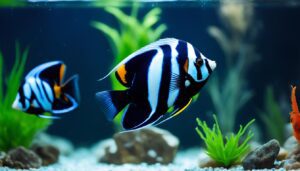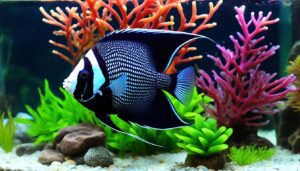I love exploring how to keep angelfish healthy. The Blushing Angelfish shines in any freshwater tank. A perfect tank shows off their beauty and keeps them happy and healthy.
These fish from South America do best in specific settings. They like tall tanks, at least 30 gallons. It’s important to know how to care for them. The right water quality, temperature, and pH are key. This info can be found in their care guide.
A good diet and proper tank conditions can help them live 8 to 15 years. I’ve made my tank a peaceful home for them. This has helped them grow in a stress-free environment. Keep reading for expert advice on caring for these beautiful fish.
If you’re looking to start with Blushing Angelfish or improve your care, stay tuned. I’ll share the joys of caring for these magnificent fish.
Understanding Blushing Angelfish Origins and Species
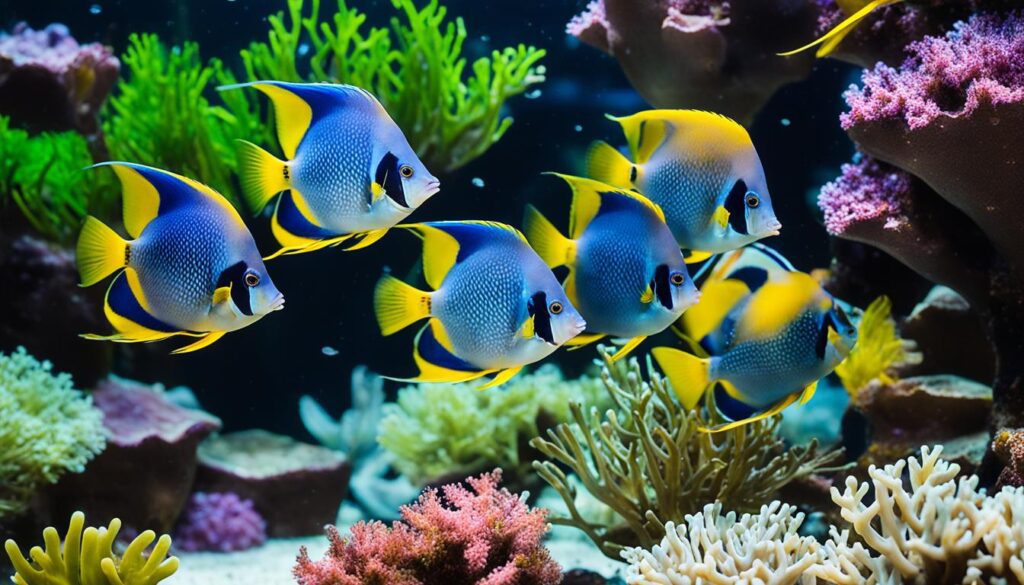
The journey into the world of blushing angelfish is fascinating. It takes us deep into the Pterophyllum genus. These freshwater angelfish have a beauty that nature uniquely crafts. Today, let’s look into their types, special traits, and the different forms they come in.
Classification and Natural Habitat
The blushing angelfish belong to the cichlids family and hail from South America’s rivers. They’re part of the Pterophyllum genus and love calm, plant-filled waters. This habitat isn’t just where they live. It’s where they gracefully swim through plants, showing their elegance.
Distinguishing Features of Pterophyllum Genus
The Pterophyllum is known for its distinct shape and movement. These angelfish are thin with triangle fins and long dorsal and anal fins. Their shape helps them slip through water, avoiding anything in their way. Their ability to hide in heavy plants shows they can adapt and survive well.
Common Varieties and Patterns
The Pterophyllum genus shows off many colors and patterns. You can find silver, veil, koi, zebra, marble, and albino angelfish among them. Each type has unique genetic features creating beautiful visuals. Koi angelfish look like koi fish with their colorful patches. Zebras stand out with striking stripes that catch your eye in the water.
Variety |
Pattern Description |
Genotype Influence |
|---|---|---|
Veil |
Elongated fins |
Presence of Veiled gene (V) |
Zebra |
Multiple vertical stripes |
Zebra mutation dominant (Z) |
Marble |
Irregular black marbling |
Marble gene (M) |
Albino |
Lack of pigment, red eyes |
Albino gene (a) |
Koi |
Orange and white patches |
Similar to koi carp genetics |
Platinum |
Solid bright silver-white |
Reflective scales |
Getting to know blushing angelfish means understanding the Pterophyllum genus’s complexity. It helps us see their evolutionary beauty and their role in nature. By exploring their world, we uncover the amazing mix of genetics, environment, and survival. This mix makes these fish not only beautiful but also strong.
Creating the Ideal Aquatic Environment for Blushing Angelfish
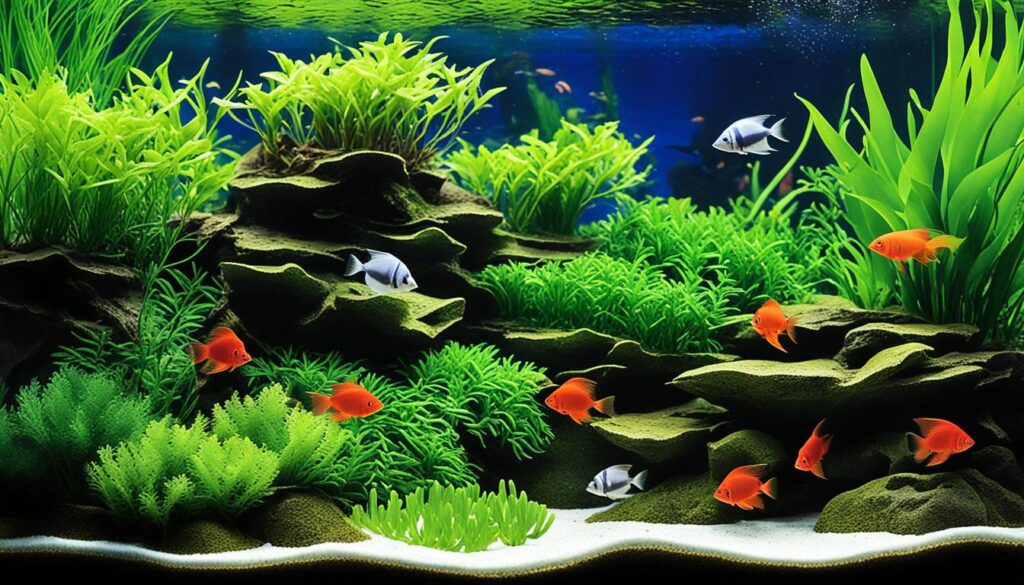
When raising blushing angelfish at home, getting the tank setup right is key. It’s important to choose the correct tank size and shape.
Optimal Tank Size and Setup Configurations
Blushing angelfish do well in tall tanks that reflect their natural deep-water homes. They need at least a 29-gallon tank for a small group. For about five or six young fish, a 55-gallon tank is perfect. This size gives them room to grow and claim their own spots.
Water Parameters for Health and Comfort
The right water conditions are crucial for angelfish health. They like water temperatures between 78-86°F and a pH from 6.0 to 8.0. Keeping these levels steady is especially important for breeding, as it helps the fish spawn successfully.
The Role of Aquatic Plants in Angelfish Tanks
Adding plants to your angelfish tank makes it look better and helps keep the water clean. It also gives the fish places to hide. Java ferns and Amazon swordplants are among the best choices. They not only make your tank healthier but also give angelfish places to lay their eggs.
Plant Type |
Benefits |
Recommended for Breeding |
|---|---|---|
Java Fern |
Easy to maintain, helps in toxin absorption |
No |
Amazon Sword |
Provides broad leaves for egg laying |
Yes |
Caring for Your Blushing Angelfish: Diet and Nutrition
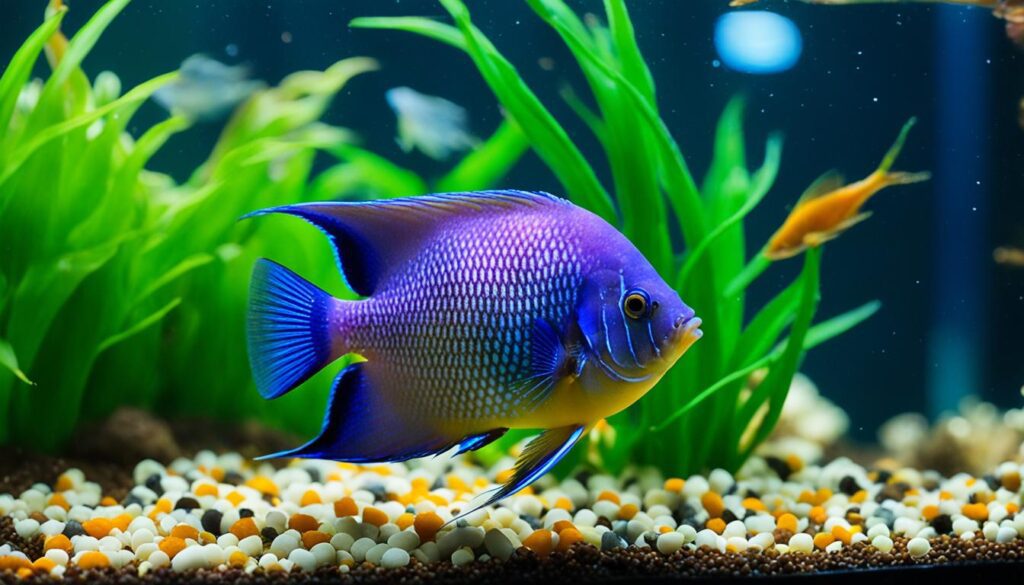
To make sure your Blushing Angelfish live long and look bright, feeding them right is vital. Knowing what they need to eat and how often is key for their health. This ensures they stay healthy and beautiful.
Understanding Angelfish Feeding Habits
Blushing Angelfish aren’t fussy eaters, but they do need a mix of foods. They eat both meat and veggies, which helps them stay healthy and look great. A good diet boosts their immune system and keeps their colors bright.
Essential Foods for Growth and Health
A mix of different foods is important for a top-notch Blushing Angelfish diet. Start with quality flakes and pellets. Then add special treats like brine shrimp, bloodworms, and tubifex worms. For grown-up fish, frozen bloodworms can even get them ready to have babies.
Feeding Tips for Angelfish Fry
When feeding baby angelfish, choose tiny, protein-rich foods for their growth. Baby brine shrimp are perfect because they are nutritious and appealing to the fry. Foods like Hikari First Bites also give the babies everything they need in their early days.
Here’s a table showing how often to feed your fish at different stages of their lives:
Age/Stage |
Type of Food |
Feeding Frequency |
|---|---|---|
Fry (0-4 weeks) |
Live baby brine shrimp, Hikari First Bites |
4-5 times a day |
Juvenile (1-6 months) |
Finely chopped bloodworms, high-quality flakes |
3-4 times a day |
Adult (6 months+) |
Frozen bloodworms, pellets, flakes |
2-3 times a day |
Changing your Blushing Angelfish diet as they grow is important for their health. Following these tips will make sure your fish don’t just live but flourish. They’ll show off their bright colors and lively personalities to the fullest.
Blushing Angelfish Size, Lifespan, and General Care
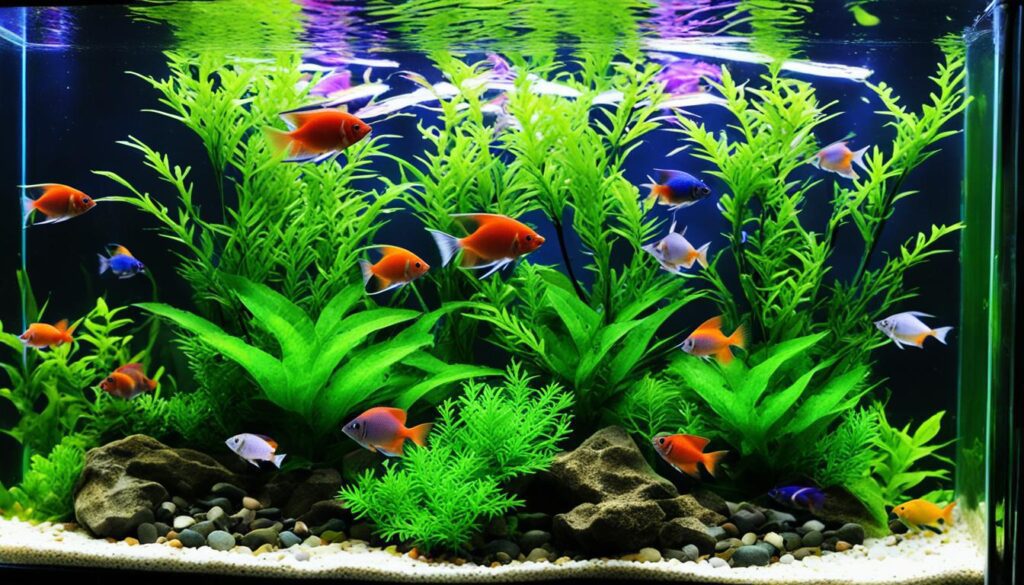
Understanding Blushing Angelfish growth size and lifespan is key for good aquarium care. They are loved not just for their beauty but also for their care needs. Let’s explore their growth and lifespan, along with care tips.
Anticipated Growth and Size
Blushing Angelfish can grow up to 6 inches long and 8 inches tall. The Altum Angelfish, their larger cousins, can reach 7 inches in length and 10-13 inches in height. These sizes show the importance of a spacious tank for their health.
Lifespan Expectations and Influencing Factors
Under ideal conditions, Blushing Angelfish live between 8 to 12 years. Their life span is affected by water quality, stress, and diet. Proper habitat maintenance is crucial for their wellbeing.
For a comprehensive look at Blushing Angelfish care, we note important details all enthusiasts should know:
Parameter |
Recommended Conditions |
|---|---|
Minimum Tank Size |
30 gallons |
Temperature Range |
75-86°F (24-30°C) |
pH Range |
5.5-7.8 |
Water Hardness |
1-15 dH |
Typical Diet |
Carnivorous, includes prepared or live food |
For healthy Blushing Angelfish, consider their breeding and social needs. They can be territorial, especially when breeding. Picking the right tank mates and creating a good habitat with hiding spots is key.
Whether you’re a seasoned aquarist or new to angelfish, understanding their care is essential. By replicating their natural habitat and keeping them healthy, Blushing Angelfish can thrive in your care. This makes caring for them a rewarding experience.
Selecting Compatible Tank Mates for Blushing Angelfish
Choosing the right friends for blushing angelfish in a community tank is vital. Their calm nature should match with peaceful tank mates. Given that P. scalare angelfish grow up to 6 inches long and 8 inches tall, it’s key to pick similarly sized companions. This ensures they won’t get bullied or harassed.
Choosing Peaceful and Non-Fin-Nipping Species
It’s crucial for angelfish to live with friends who don’t pick fights. Peaceful fish like black skirt tetras and adult cardinal tetras are perfect. They’re calm and won’t nip at fins. Cory catfish are also great since they stick to the bottom, leaving angelfish free to swim up high. Avoid fast, small fish that might stress out your angelfish or compete for food.
Community Tank Considerations and Tips
To create a peaceful tank, choose the right fish and set up. This article on angelfish care is filled with helpful tips. Start with at least a 29-gallon tank for four adult angelfish. This gives them enough room to swim and have their own space.
Keeping the water between 78-86°F and a pH of 6.0 to 8.0 is best for Angelfish and their friends. Sometimes, having just one angelfish can make the tank more peaceful, allowing for a wider variety of fish to join.

